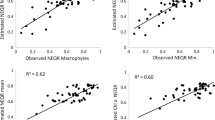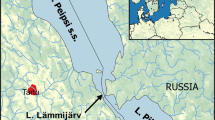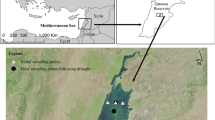Abstract
Phosphorus and nitrogen are key nutrients that affect abundance and growth of aquatic primary producers but cannot be directly remotely sensed as their dissolved or organic forms do not interact with the remote sensing signal. In addition, other lake water quality variables such as chlorophyll a and Secchi disk depth, have been previously successfully estimated with remote sensing, but the retrieval algorithms are site-, season-, and/or scene-specific. Such algorithms do not take into account lake typological features, which can affect the sensitivity of lake to change, or catchment characteristics, for example, land cover that is a major driver of lake water quality change. Here we propose a novel approach that utilises remotely sensed land cover information in the catchment to estimate phosphorus, nitrogen and chlorophyll a concentrations in lake waters. We use land cover type-specific nutrient export coefficients and the NASA MODIS (Moderate Resolution Imaging Spectroradiometer) Land Cover Type product showing that nutrient loading based on remote sensing can explain up to 75% of variability in lake nutrient concentrations and 58% of variability in lake chlorophyll a concentrations. In addition, we show that land cover information, supplemented by satellite measurements and lake morphometry data are good predictors of chlorophyll a (R2 = 0.77) and Secchi disk depth (R2 = 0.87) in lakes with different trophic statuses and in different months and years.








Similar content being viewed by others
References
Adrian R, O’Reilly CM, Zagarese H, Baines SB, Hessen DO, Keller W, Livingstone DM, Sommaruga R, Straile D, Van Donk E, Weyhenmeyer GA, Winder M (2009) Lakes as sentinels of climate change. Limnol Oceanogr 54:2283–2297
Allee RJ, Johnson JE (1999) Use of satellite imagery to estimate surface chlorophyll a and Secchi disc depth of Bull Shoals Reservoir, Arkansas, USA. Int J Remote Sens 20:1057–1072
Baban SMJ (1993) Detecting water quality parameters in the Norfolk Broads, UK, using Landsat scenery. Int J Remote Sens 14:1247–1267
Chipman JW, Lillesand TM, Schmaltz JE, Leale JE, Nordheim MJ (2004) Mapping lake clarity with Landsat images in Wisconsin, U.S.A. Can J Remote Sens 30:1–7
Dekker AG, Peters SWM (1993) The use of the Thematic Mapper for the analysis of eutrophic lakes: a case study in the Netherlands. Int J Remote Sens 14:799–821
Endreny TA, Wood EF (2003) Watershed weighting of export coefficients to map critical phosphorus loading areas. J Am Water Resour Assoc 39(1):165–181
Foody GM (2002) Status of land cover classification accuracy assessment. Remote Sens Environ 80:185–201
George DG (1997) The airborne remote sensing of phytoplankton chlorophyll in the lakes and tarns of the English Lake District. Int J Remote Sens 18:1961–1975
Han L, Rundquist DC, Liu LL, Fraser RN, Schalles JF (1994) The spectral responses of algal chlorophyll in water with varying levels of suspended sediment. Int J Remote Sens 15(18):3707–3718
Hanrahan G, Gledhill M, House WA, Worsfold PJ (2001) Phosphorus loading in the Frome catchment, UK: Seasonal refinement of the coefficient modelling approach. J Environ Qual 30(5):1738–1746
Heathcote A, del Giorgio PA, Prairie YT (2015) Predicting bathymetric features of lakes from the topography of their surrounding landscape. Can J Fish Aquat Sci 72:643–650
Hedger RD, Atkinson PM, Malthus TJ, George DG (1996) Planning optimal sampling strategies for estimating the regional mean water quality in lakes. Proceedings of the 22nd Annual Conference of the Remote Sensing Society, 11–14 September 1996, University of Durham, UK, pp 221–228
Hollister J, Milstead WB (2010) Using GIS to estimate lake volume from limited data. Lake Reservoir Management 26:194–199. https://doi.org/10.1080/07438141.2010.504321
Horne AJ, Goldman CR (1994) Limnology, second edition. McGraw-Hill, USA
Huang J, Zhan J, Yan H, Wu F, Deng X (2013) Evaluation of the impacts of land use on water quality: A case study in the Chaohu lake basin. The Scientific World Journal 2013. https://doi.org/10.1155/2013/329187
Jensen JR (2000) Remote sensing of the environment. An Earth resource perspective. Prentice-Hall, USA
Jones RA, Lee GF (1982) Recent advances in assessing the impact of phosphorus in eutrophication-related water quality. J Water Res 16:503–515
Kallio K, Kutser T, Hannonen T, Koponen S, Pulliainen J, Vepsäläinen J, Pyhälahti T (2001) Retrieval of water quality from airborne imaging spectrometry of various lake types in different seasons. Sci Total Environ 268:59–77
Kallio K, Koponen S, Pulliainen J (2003) Feasibility of airborne imaging spectrometry for lake monitoring – a case study of spatial chlorophyll a distribution in two meso-eutrophic lakes. Int J Remote Sens 24:3771–3790
Keatly BE, Bennett EM, MacDonald GK, Taranu ZE, Gregory-Eaves I (2011) Land-use legacies are important determinants of lake eutrophication in the Anthropocene. PLoS One 6(1):e15913. https://doi.org/10.1371/journal.pone.0015913
Koponen S, Poulliainen J, Kallio K, Hallikainen M (2002) Lake water quality classification with airborne hyperspectral spectrometer and simulated MERIS data. Remote Sens Environ 79:51–59
Kottek M, Grieser J, Beck C, Rudolf B, Rubel F (2006) World Map of the Köppen-Geiger climate classification updated. Meteorol Z 15:259–263
Lavender SJ, Pinkerton MH, Froidefond J-M, Morales J, Aiken J, Moore GF (2004) SeaWiFS validation in European coastal waters using optical and bio-geochemical measurements. Int J Remote Sens 25:1481–1488
Lee Z, Shang S, Qi L, Yan J, Lin G (2016) A semi-analytical scheme to estimate Secchi-disk depth from Landsat-8 measurements. Remote Sens Environ 177:101–106
Lewis SL, Maslin MA (2015) Defining the Anthropocene. Nature 519:171–180
Lin JP (2004) Review of published export coefficient and event mean concentration (EMC) data. Technical Notes Collection (ERDC TN-WRAP-04–3), Wetlands Regulatory Assistance Program. US Army Engineer Research and Development Centre, Vicksburg, p. 15
Liu J, Diamond J (2005) China’s environment in a globalizing world. Nature 435:1179–1186
Matthews MW (2011) A current review of empirical procedures of remote sensing in inland and near-coastal transitional waters. Int J Remote Sens 32:6855–6899. https://doi.org/10.1080/01431161.2010.512947
McCullough IM, Loftin CS, Sader SA (2012) Combining lake and watershed characteristics with Landsat TM data for remote estimation of regional lake clarity. Remote Sens Environ 123:109–115
Nellis MD, Harrington JA, Wu J (1998) Remote sensing of temporal and spatial variations in pool size, suspended sediment, turbidity and Secchi depth in Tuttle Creek Reservoir., Kansas: 1993. Geomorphology 21:281–293
O’Reilly CM, Sharma S, Gray DK, Hampton SE, Read JS, Rowley RJ, Schneider P, Lenters JD, McIntyre PB, Kraemer BM, Weyhenmeyer GA, Straile D, Dong B, Adrian R et al (2015) Rapid and highly variable warming of lake surface waters around the globe. Geophys Res Lett 42:10773–10781. https://doi.org/10.1002/2015GL066235
Odermatt D, Gitelson A, Brando VE, Schaepman M (2012) Review of constituent retrieval in optically deep and complex waters from satellite imagery. Remote Sens Environ 118:116–126
Olmanson LG, Bauer ME, Brezonik PL (2008) A 20-year Landsat water clarity census of Minnesota’s 10,000 lakes. Remote Sens Environ 112:4086–4097
Olmanson LG, Brezonik PL, Finlay JC, Bauer ME (2016) Comparison of Landsat 8 and Landsat 7 for regional measurements of CDOM and water clarity in lakes. Remote Sens Environ 185:119–128
Olson DM, Dinerstein E, Wikramanayake ED, Burgess ND, Powell GVN, Underwood EC, D’Amico JA, Itoua I, Strand HE, Morrison JC, Loucks CJ, Allnutt TF, Ricketts TH, Kura Y, Lamoreux JF, Wettengel WW, Hedao P, Kassem KR (2001) Terrestrial ecoregions of the world: a new map of life on Earth. Bioscience 51:933–938
Palmer SCJ, Hunter PD, Lankester T, Hubbard S, Spyrakos E, Tyler AN, Présing M, Horváth H, Lamb A, Balzter H, Tóth VR (2014) Validation of Envisat MERIS algorithms for chlorophyll retrieval in a large, turbid and optically complex shallow lake. Remote Sens Environ. https://doi.org/10.1016/j.rse.2014.07.024
Politi E, Cutler MEJ, Rowan JS (2015) Evaluating the spatial transferability and temporal repeatability of remote-sensing-based lake water quality retrieval algorithms at the European scale: a meta-analysis approach. Int J Remote Sens 36(11):2995–3023. https://doi.org/10.1080/01431161.2015.1054962
Pulliainen J, Kallio K, Eloheimo K, Koponen S, Servomaa H, Hannonen T, Tauriainen S, Hallikainen M (2001) A semi-operative approach to lake water quality retrieval from remote sensing data. Sci Total Environ 268:79–93
Rast W, Lee GF (1977) Summary analysis of the North American (US Portion) OECD eutrophication project: Nutrient loading-lake response relationship and trophic status indices. US EPA Report No. EPA/3-78-008, Ecological Research Series. US Environmental Protection Agency, Oregon
Rast W, Lee GF (1983) Nutrient loading estimates for lakes. J Environ Eng 109:502–518
Rast W, Thornton JA (2005) The phosphorus loading concept and the OECD eutrophication programme: origin, application and capabilities. In: O’Sullivan P, Reynolds CS (eds) “The Lakes Handbook”. Volume 2: Lake restoration and rehabilitation. Blackwell, UK
Reckhow KH, Simpson JT (1980) A procedure using modelling and error analysis for the prediction of lake phosphorus concentration from land use information. Can J Fish Aquat Sci 37:1439–1448
Reckhow KH, Beaulac MN, Simpson JT (1980) Modelling phosphorus loading and lake response under uncertainty: a manual and compilation of export coefficients. In: EPA 440/5-80-011. US Environmental Protection Agency, Washington, DC
Reid GK (1961) Ecology of inland waters and estuaries. Reinhold, USA
Sawaya KE, Olmamson LG, Heinert NJ, Brezonik PL, Bauer ME (2003) Extending satellite remote sensing to local scales: land and water resource monitoring using high – resolution imagery. Remote Sens Environ 88:144–156
Skidmore AK (2002) Taxonomy of environmental models in the spatial sciences. In: Skidmore AK (ed) Environmental modelling with GIS and remote sensing. Taylor and Francis, London, pp 8–23
Smith VH, Schindler DW (2009) Eutrophication science: where do we go from here? Trends in Ecology Evolution 24:201–207. https://doi.org/10.1016/j.tree.2008.11.009
Sobek S, Nisell J, Fölster J (2011) Predicting the volume and depth of lakes from map-derived paramters. Inland Waters 1:177–184
Tebbs EJ, Remedios JJ, Harper DM (2013) Remote sensing of chlorophyll-a as a measure of cyanobacterial biomass in Lake Bogoria, a hypertrophic, saline–alkaline, flamingo lake, using Landsat ETM+. Remote Sens Environ 135:92–106
Thiemann S, Kaufmann H (2000) Determination of chlorophyll content and trophic state of lakes using field spectrometer and IRS-1C satellite data in the Mecklenburg Lake District, Germany. Remote Sens Environ 73:227–235
Tyler AN, Svab E, Preston T, Présing M, Kovács WA (2006) Remote sensing of the water quality of shallow lakes: a mixture modelling approach to quantifying phytoplankton in water characterized by high-suspended sediment. Int J Remote Sens 27:1521–1537
US EPA (2013) Impacts of climate change on the occurrence of harmful algal blooms. EPA Office of Water Report 820-S-13-001
Vollenweider RA (1976) Advances in defining critical loading levels for phosphorus in lake eutrophication. Mem Inst ltal Idrobiol 33:53–83
Welch PS (1935) Limnology. McGraw-Hill, USA
Williamson CE, Saros JE, Vincent WF, Smol JP (2009) Lakes and reservoirs as sentinels, integrators, and regulators of climate change. Limnol Oceanogr 54:2273–2282
Williamson CE, Brentrup JA, Zhang J, Renwick WH, Hargreaves BR, Knoll LB, Overholt EP, Rose KC (2014) Lakes as sensors in the landscape: optical metrics as scalable sentinel responses to climate change. Limnol Oceanogr 59:840–850
Wilson HM (2005) The export coefficient approach to prediction of nutrient loadings: Errors and uncertainties in the British experience. In: O’Sullivan P, Reynolds CS (eds) The lakes handbook. Volume 2: Lake restoration and rehabilitation. Blackwell, UK
Wochna A, Lange K, Urbanski J (2011) The influence of land cover change during sixty years on non point source phosphorus loads to Gulf of Gdansk. J Coast Res SI 64:1820–1824
Yang X, Lu X (2014) Drastic change in China’s lake and reservoirs over the past decades. Sci Rep 4:6041. https://doi.org/10.1038/srep06041
Acknowledgements
This research work was partially funded by a Scottish Alliance for Geoscience, Environment and Society (SAGES) Postdoctoral and Early Career Researcher Exchange (PECRE) award, and the United Kingdom (UK) Natural Environment Research Council (NERC) GloboLakes project (NE/J024279/1). The authors would like to thank Université du Québec à Montréal for the provision of facilities to support this work and in situ measurements. Many thanks to the Editor and anonymous Reviewers for their insightful comments that greatly improved this manuscript.
Author information
Authors and Affiliations
Corresponding author
Rights and permissions
About this article
Cite this article
Politi, E., Prairie, Y.T. The potential of Earth Observation in modelling nutrient loading and water quality in lakes of southern Québec, Canada. Aquat Sci 80, 8 (2018). https://doi.org/10.1007/s00027-017-0559-7
Received:
Accepted:
Published:
DOI: https://doi.org/10.1007/s00027-017-0559-7




